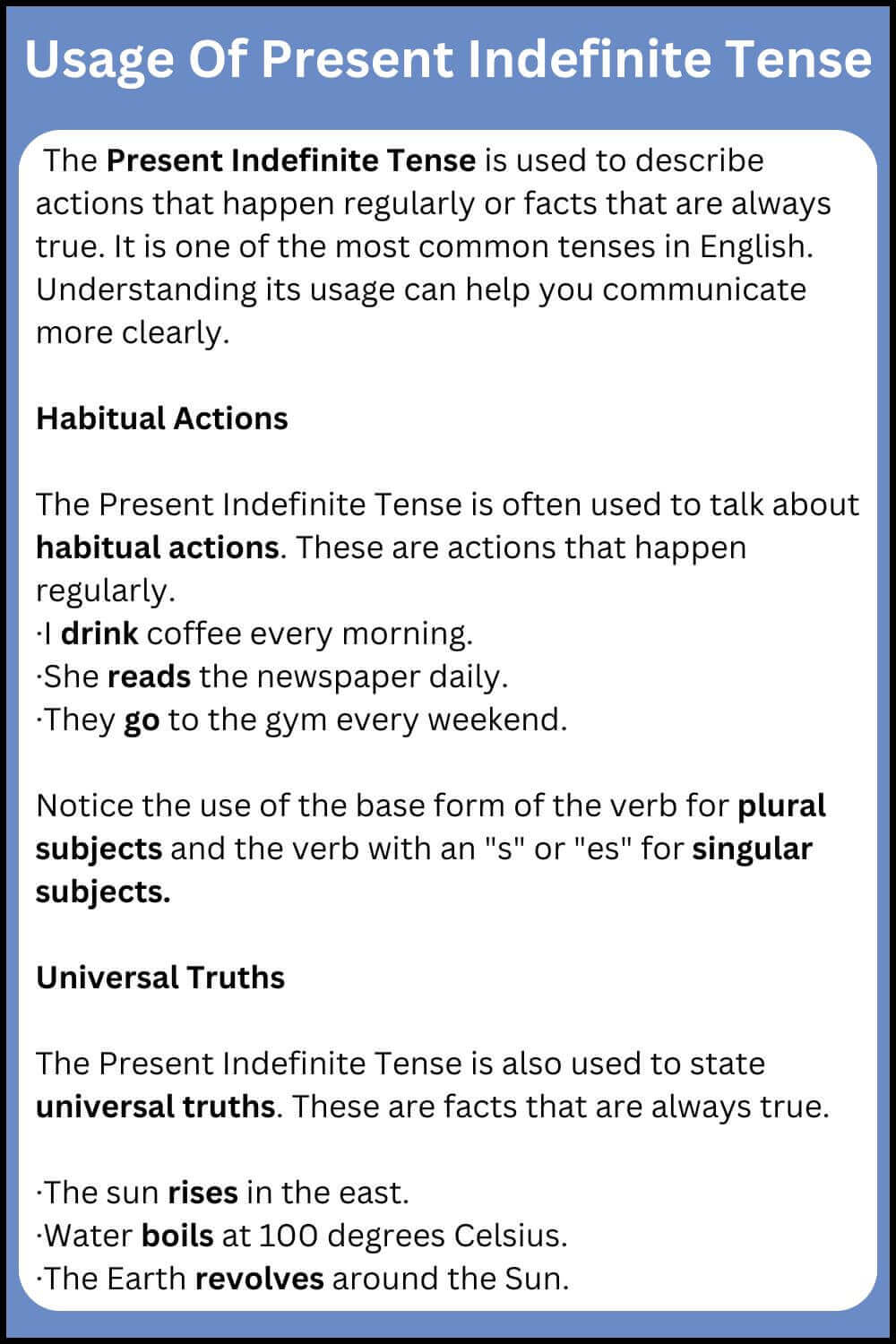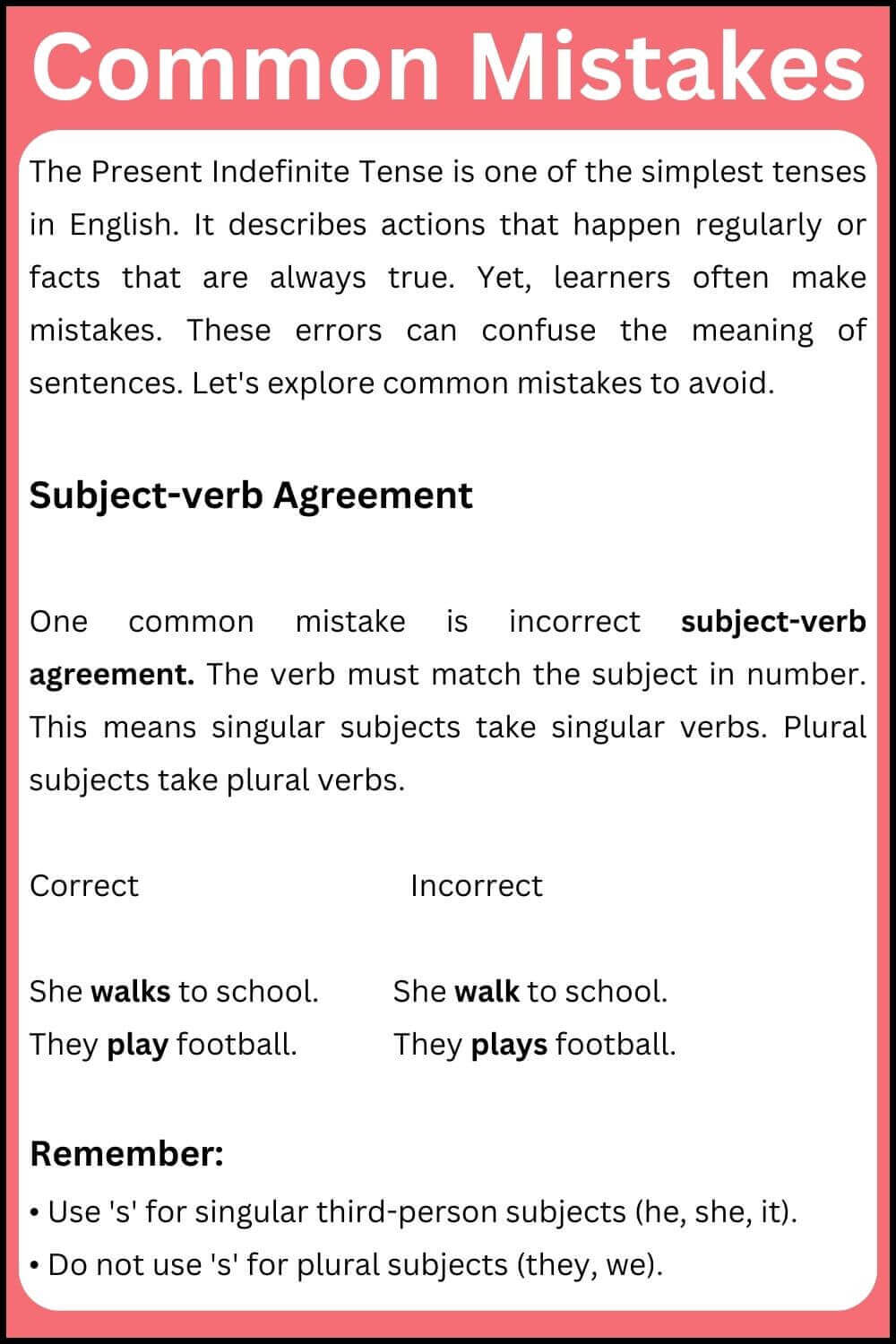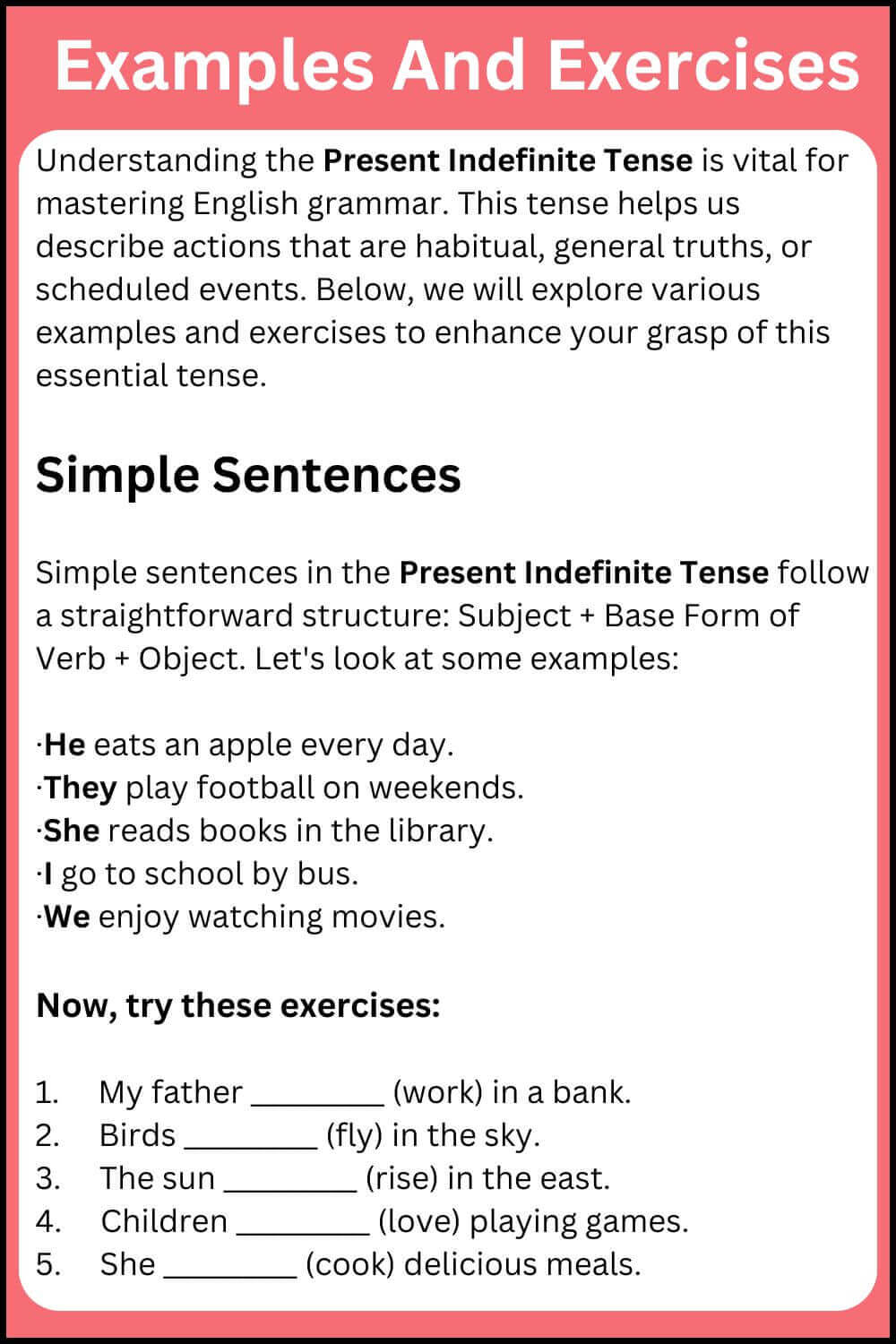The Present Indefinite Tense is essential in English. It describes regular actions and universal truths.
Understanding the Present Indefinite Tense helps in daily communication. It’s used to talk about habits, general facts, and routines. For example, “She reads every day” or “The sun rises in the east. ” This tense is simple to learn and use.
Whether you’re a student or someone learning English, mastering this tense can improve your speaking and writing skills. It forms the foundation of many sentences in English. Let’s dive in to explore how this tense works and how you can use it effectively in your conversations and writing.
Introduction to Present Indefinite Tense
The Present Indefinite Tense, also known as the Simple Present Tense, is a fundamental part of English grammar. It describes actions that are habitual, general truths, or facts. Understanding this tense is key to effective communication.
What Is Present Indefinite Tense?
The Present Indefinite Tense expresses actions that happen regularly or facts that are always true. We use the base form of the verb for most subjects. Add an “s” or “es” for third-person singular subjects.
Here is a simple structure:
|
Subject |
Verb | Example |
|
I/You/We/They |
base verb |
I play. |
| He/She/It | verb + s/es |
She plays. |
Importance In Daily Communication
The Present Indefinite Tense is crucial in daily communication. It helps convey routine activities and universal truths. For example:
- Routine actions: “I go to school every day.”
- General truths: “The sun rises in the east.”
Using this tense correctly ensures clarity and precision in your speech and writing.
Structure Of Present Indefinite Tense
The Present Indefinite Tense is one of the most common tenses in English. It is used to describe habitual actions, general truths, and fixed arrangements. Understanding its structure is crucial for building sentences correctly. Let’s dive into the structure of present indefinite tense.
Affirmative Sentences
In affirmative sentences, the structure is simple. It follows the pattern:
- Subject + Base Form of Verb + Object
For example:
- I play football.
- She reads books.
Notice the base form of the verb. For third person singular subjects (he, she, it), add an -s or -es to the verb:
- He plays
- It rains
Negative Sentences
In negative sentences, use the auxiliary verb “do” or “does” with “not”. The structure is:
- Subject + Do/Does + Not + Base Form of Verb + Object
For example:
- I do not play football.
- She does not read books.
Remember, for third person singular subjects, use “does not” instead of “do not”.
Interrogative Sentences
In interrogative sentences, the structure changes slightly. The pattern is:
- Do/Does + Subject + Base Form of Verb + Object?
For example:
- Do you play football?
- Does she read books?
Use “do” for plural subjects and “does” for singular third person subjects.
Here is a table summarizing the structures:
| Type | Structure | Example |
| Affirmative | Subject + Base Form of Verb + Object | I play football. |
| Negative | Subject + Do/Does + Not + Base Form of Verb + Object | She does not read books. |
| Interrogative | Do/Does + Subject + Base Form of Verb + Object? | Do you play football? |
Usage Of Present Indefinite Tense
The Present Indefinite Tense is used to describe actions that happen regularly or facts that are always true. It is one of the most common tenses in English. Understanding its usage can help you communicate more clearly.
Habitual Actions
The Present Indefinite Tense is often used to talk about habitual actions. These are actions that happen regularly.
- I drink coffee every morning.
- She reads the newspaper daily.
- They go to the gym every weekend.
Notice the use of the base form of the verb for plural subjects and the verb with an “s” or “es” for singular subjects.
Universal Truths
The Present Indefinite Tense is also used to state universal truths. These are facts that are always true.
- The sun rises in the east.
- Water boils at 100 degrees Celsius.
- The Earth revolves around the Sun.
In these sentences, the verbs describe actions or states that are always the same.

Scheduled Events
We use the Present Indefinite Tense to talk about scheduled events. These are events that are planned and occur regularly.
- The train leaves at 6 PM.
- The store opens at 9 AM every day.
- Our meeting starts at 10 AM on Mondays.
These sentences show activities that are fixed and part of a schedule.
Common Mistakes
The Present Indefinite Tense is one of the simplest tenses in English. It describes actions that happen regularly or facts that are always true. Yet, learners often make mistakes. These errors can confuse the meaning of sentences. Let’s explore common mistakes to avoid.
Subject-verb Agreement
One common mistake is incorrect subject-verb agreement. The verb must match the subject in number. This means singular subjects take singular verbs. Plural subjects take plural verbs.
|
Correct |
Incorrect |
|
She walks to school. |
She walk to school. |
| They play football. |
They plays football. |
Remember:
- Use ‘s’ for singular third-person subjects (he, she, it).
- Do not use ‘s’ for plural subjects (they, we).

Incorrect Verb Forms
Another mistake involves using incorrect verb forms. The base form of the verb is used with most subjects. For third-person singular subjects, add ‘s’ or ‘es’.
- I eat breakfast at 7 AM.
- She eats breakfast at 7 AM.
Common errors include:
- Using the base form with third-person singular subjects.
- Adding ‘s’ or ‘es’ to plural subjects.
Let’s look at some examples:
| Correct | Incorrect |
| He goes to the gym. | He go to the gym. |
| We study English. | We studies English. |
Always check the subject before choosing the verb form. This will help you avoid these common mistakes.
Time Expressions
Understanding time expressions is crucial for using the Present Indefinite Tense correctly. These expressions help define the frequency or specific time when an action occurs. Let’s explore the various time expressions used with this tense.
Frequency Adverbs
Frequency adverbs are words that tell us how often an action happens. They are often used with the Present Indefinite Tense. Here are some common frequency adverbs:
- Always
- Usually
- Often
- Sometimes
- Rarely
- Never
These adverbs are typically placed before the main verb. For example:
- She always eats breakfast.
- He never skips his workouts.
Specific Time Phrases
Specific time phrases indicate exact times when actions occur. They can be days, parts of the day, or other specific times. Here are some examples:
- Every day
- Each morning
- On Mondays
- At 7 AM
These phrases usually come at the beginning or end of the sentence. For example:
- Every day, she reads the newspaper.
- They play tennis on Sundays.
Examples And Exercises
Understanding the Present Indefinite Tense is vital for mastering English grammar. This tense helps us describe actions that are habitual, general truths, or scheduled events. Below, we will explore various examples and exercises to enhance your grasp of this essential tense.
Simple Sentences
Simple sentences in the Present Indefinite Tense follow a straightforward structure: Subject + Base Form of Verb + Object. Let’s look at some examples:
- He eats an apple every day.
- They play football on weekends.
- She reads books in the library.
- I go to school by bus.
- We enjoy watching movies.
Now, try these exercises:
- My father __________ (work) in a bank.
- Birds __________ (fly) in the sky.
- The sun __________ (rise) in the east.
- Children __________ (love) playing games.
- She __________ (cook) delicious meals.

Complex Sentences
Complex sentences in the Present Indefinite Tense may include conjunctions or additional clauses. Here are some examples:
- Whenever he feels tired, he takes a nap.
- If it rains, we stay
- Although she works hard, she finds time to relax.
- Since he lives nearby, he walks to work.
- After they finish dinner, they watch
Try these exercises:
- Whenever I __________ (feel) hungry, I __________ (eat) a snack.
- If she __________ (study) hard, she __________ (pass) the exam.
- Although they __________ (work) late, they __________ (wake up) early.
- Since we __________ (love) nature, we __________ (go) hiking.
- After he __________ (complete) his homework, he __________ (play) video games.
These examples and exercises will help you understand and use the Present Indefinite Tense effectively. Practice regularly to improve your skills.
Tips For Mastery
Mastering the Present Indefinite Tense can enhance your English fluency. This tense describes habits, general truths, and fixed arrangements. To help you master it, here are some tips.
Practice Regularly
Consistent practice is essential. Set aside time each day to practice. Create sentences using the present indefinite tense. Write about your daily routine or describe objects around you.
- Example: “I go to school every day.”
- Example: “The sun rises in the east.”
Practice with a partner. Correct each other’s sentences. This helps identify mistakes and learn from them.
Engage In Conversations
Speaking is a great way to learn. Engage in conversations using the present indefinite tense. Talk about your hobbies, habits, and routines.
| Question | Example Answer |
| What do you do every morning? | “I brush my teeth.” |
| What is your favorite hobby? | “I read books.” |
Join English-speaking groups or clubs. Practice with native speakers. Listen to how they use the present indefinite tense.
Remember, consistency and practice are key. Use these tips to improve your understanding and usage of the present indefinite tense.
.
Frequently Asked Questions
What Is The Present Indefinite Tense?
The Present Indefinite Tense describes habitual actions, general truths, and fixed arrangements. It uses the base form of the verb.
How Do You Form The Present Indefinite Tense?
To form the Present Indefinite Tense, use the base form of the verb. Add ‘s’ or ‘es’ for third-person singular.
When Do We Use The Present Indefinite Tense?
We use the Present Indefinite Tense for daily routines, habits, and universal truths. It also describes scheduled events.
What Are Examples Of Present Indefinite Tense Sentences?
Examples include “She writes daily,” “He plays soccer,” and “Water boils at 100 degrees. ” These sentences show regular actions.

